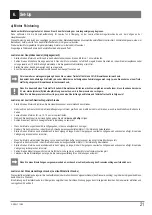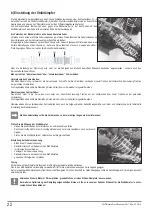
35
© REELY 10/08
35
35
b) Drive mode:
Before starting:
Check all bolted connections and all wheel nuts.
Make sure that the rechargeable batteries (batteries) of both transmitter and receiver are completely charged.
1. Both control levers in neutral position, 2. Switch on remote control transmitter and 3. Receiver
Never drive if your ability to respond is limited (e.g. when tired, under medication or under the influence of alcohol).
Incorrect responses can cause serious damages to people and objects.
Do not drive in the direction of gathered people, persons or animals!
Always keep visual contact to your model!
Do not drive at night.
Never drive on roads, which are opened to public road traffic!
Take note of possible conditions and regulations for the site.
Never drive without air filter!
Check regularly all bolt connections and fasteners,
as they may get loosened or detached due to the vibrations of the engine.
Avoid long driving in the part-load operational range
, since otherwise, engine and clutch (missing air cooling) will overheat!
Avoid driving at very low outdoor temperatures.
The synthetic material of the car body loses its elasticity; Therefore, even small collisions may cause chippings and fractures.
c) Remote control:
Before starting, check the range of your remote control system.
Firmly screw the transmitter antenna and pull it out to its entire length.
An antenna that is not completely pulled out reduces the range of the remote control transmitter.
Check, on the stationary model, whether the servos respond to the signal of the remote control!
Check the charge level indicator of your remote control!
Weak or empty rechargeable batteries (batteries) can cause you to lose control over your model.
Make sure that nobody else is transmitting in the proximity of your frequency!
Interfering signals on the same frequency can make you lose the control over your model.
Also, when using different modulation types (FM, PPM, AM, PCM), the same frequencyshould not be used.
Do not drive under high voltage power lines or radio masts.
Do not drive in the case of thunderstorms!
Atmospheric interferences can affect the signals of your remote control transmitter.
Don’t drive in the rain, through wet grass, water, mud or snow.
The components of your RC system are not waterproof!
Make sure that the throttle/brake servo is in idle position.
Always let the remote control and the receiver turned on whilst the engine is running!
Switching off: 1. switch off the engine, 2. the receiver then the transmitter!
d) General information:
Remove the rechargeable batteries of the receiver if you are not using the latter for a longer period of time.
Never mix rechargeable batteries with dry-cell batteries.
Never mix full and half full rechargeable batteries /batteries or rechargeable batteries with different capacities.
Otherwise, the weaker rechargeable batteries / batteries or rechargeable batteries with low capacity can be totally discharged and can leak.
Never try to charge dry cell batteries.
This can cause leakage and in the worst case can cause an explosion
Defective / rechargeable batteries which cannot be recharged any more are a hazardous waste (recycling sites).
It is forbidden to dispose of them via the household rubbish!
Take note of the warning notes and the equipment
regulations
that are specific to the vehicle!
Only use original spare parts!
Take note of the separate operating manuals
of accessories such as remote control, rechargeable batteries and chargers.
Ensure extra lengths and loose hanging cables with thin cable fasteners!
Ensure, in particular, that lines do not get into moving parts.
•
•
•
•
•
•
•
•
•
•
•
•
•
•
•
•
•
•
•
•
•
•
•
•
•
•
•
•
•
•
•
•
•
•
•
Summary of Contents for 23 58 10
Page 122: ...121 REELY 12 08 121 121 ...
Page 123: ...122 4WD MonsterTruck Destroyer XXL 1 8 No 23 58 10 ...
Page 124: ...123 REELY 12 08 123 123 ...
















































